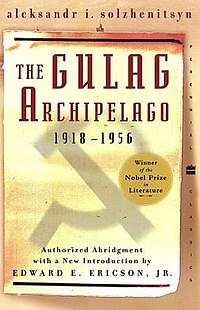Gulag Archipelago
 |
|
| Author | Aleksandr Solzhenitsyn |
|---|---|
| Original title | Архипелаг ГУЛАГ |
| Translator |
Geneviève Johannet, José Johannet, Nikita Struve (French) Thomas P. Whitney (English) |
| Country | France |
| Language | Russian |
| Publisher | Éditions du Seuil |
|
Publication date
|
1973 |
|
Published in English
|
1974 |
| Media type | Print (Hardback & Paperback) |
| ISBN | |
| OCLC | 802879 |
| 365/.45/0947 | |
| LC Class | HV9713 .S6413 1974 |
The Gulag Archipelago (Russian: Архипелаг ГУЛАГ, Arkhipelag GULAG) is a book by Aleksandr Solzhenitsyn about the Soviet forced labor camp system. The three-volume book is a narrative relying on eyewitness testimony and primary research material, as well as the author's own experiences as a prisoner in a gulag labor camp. Written between 1958 and 1968, it was published in the West in 1973 and, thereafter, circulated in samizdat (underground publication) form in the Soviet Union until its appearance in the Russian literary journal, Novy Mir, in 1989, in which a third of the work was published over three issues.
GULag or Gulág is an acronym for the Russian term Glavnoye Upravleniye ispravitelno-trudovyh Lagerey (Главное Управление Исправительно-трудовых Лагерей), or "Chief Administration of Corrective Labour Camps", the bureaucratic name of the governing board of the Soviet labour camp system, and by metonymy, the camp system itself. The original Russian title of the book is Arkhipelag GuLag, the rhyme supporting the underlying metaphor deployed throughout the work. The word archipelago compares the system of labor camps spread across the Soviet Union with a vast "chain of islands", known only to those who were fated to visit them.
Since the dissolution of the Soviet Union and the formation of the Russian Federation, The Gulag Archipelago has been officially published, and it has been included in the high school program in Russia as mandatory reading since 2009.
Structurally, the text comprises seven sections divided (in most printed editions) into three volumes: parts 1–2, parts 3–4, and parts 5–7. At one level, the Gulag Archipelago traces the history of the system of forced labor camps that existed in the Soviet Union from 1918 to 1956, starting with V.I. Lenin's original decrees shortly after the October Revolution establishing the legal and practical framework for a series of camps where political prisoners and ordinary criminals would be sentenced to forced labor. It describes and discusses the waves of purges, assembling the show trials in context of the development of the greater Gulag system with particular attention to the legal and bureaucratic development.
...
Wikipedia
